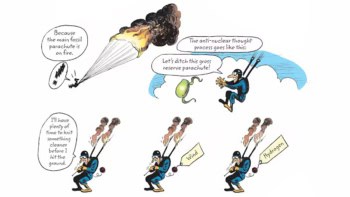Researchers in the UK claim to have the first firm evidence that rising sea–surface temperatures have boosted the intensity and incidence of hurricanes that form in the tropical North Atlantic, Caribbean and Gulf of Mexico. Mark Saunders and Adam Lea of University College London (UCL) say that a 0.5° increase in the temperature of the ocean surface results in a 40% increase in hurricane activity.
Climate scientists have long suspected that warmer oceans mean more hurricanes. In the 1950s and 1960s, the sea–surface temperature (SST) in the tropical North Atlantic was relatively high and hurricanes were relatively common, while in the 1970s and 1980s, the temperature dipped by as much as 0.5 °C and the intensity and incidence of storms also dropped. Then in the 1990s, the temperature began to increase along with hurricane activity.
Notoriously complex
However, the Earth’s climate is a notoriously complex system and researchers have struggled to establish a direct relationship between SST and hurricanes. An important complicating factor is that changing wind patterns over the Atlantic play an important role in hurricane formation — and it had been tricky to determine the relative impact of wind and temperature.
Saunders and Lea have now got around this problem by doing a careful statistical analysis of storm, SST and wind data stretching back to 1965 (Nature 451 557). First, they showed that about 75–80% of the variation in hurricane activity was a direct result of changes in the SST and wind patterns. Then, they assumed that the temperature and wind patterns had independent effects on hurricane intensity and used an analysis technique called multiple linear regression to remove the influence of wind.
Accumulated cyclone energy
The researchers described the hurricane frequency and intensity in terms of the accumulated cyclone energy (ACE) index for the North Atlantic, which measures the total energy dissipated by hurricanes. ACE is considered the most meaningful measure of hurricane activity because it combines intensity and duration of all tropical storms in a given season.
They found that a 0.5 °C increase in SST boosted the ACE by about 40%. Furthermore, they say that much of the recent increase in the ACE since 1996 can be attributed to a rise in the SST.
While Saunders and Lea were able to link SST to hurricane activity, their work says nothing about why the SST has increased over the past 40 years. According to Saunders, this could be down to global warming or it could be part of the cyclical variation of SST called the Atlantic multidecadal oscillation, which seems to occur with a period of about 60–80 years.
Improved climate models
However, Saunders told physicsworld.com that the result should help researchers develop models that try to predict the outcomes of climate change, because in order to be correct, these models should reproduce the observed connection between increasing SST and hurricane activity.
According to Stefan Rahmstorf, a physicist at the Institute for Climate Impact Research at Potsdam University in Germany, this latest work backs up previous studies that suggest that the connection between SST and ACE is very strong indeed. “What is remarkable in this study (and similar previous studies) is how strong the effect of a very modest warming of half a degree is”, Rahmstorf told physicsworld.com “It makes you wonder what kind of hurricane activity you’d get after three degrees warming.”
Saunders, however, is more cautious about predicting what would happen if the SST rose by such an amount. It is possible, for example, that the SST is currently at a critical value for hurricane formation and small deviations cause large changes in hurricane activity. This might not be the case if climate change caused the SST to rise by several degrees.


